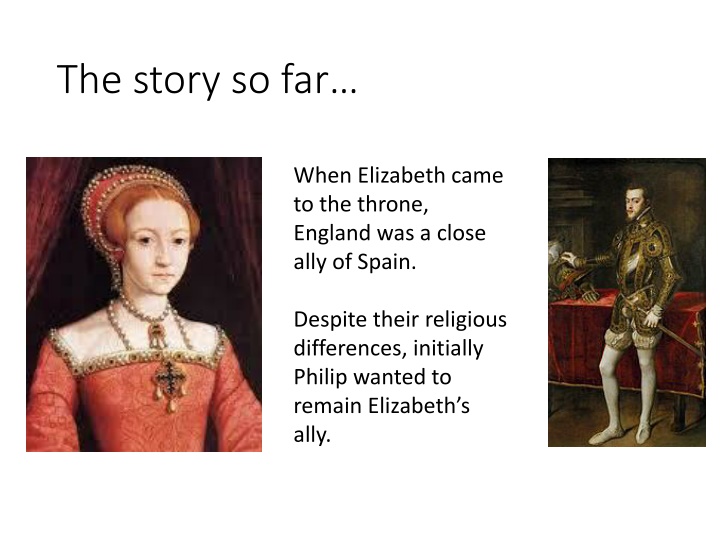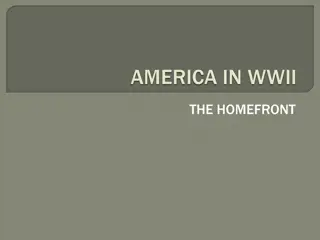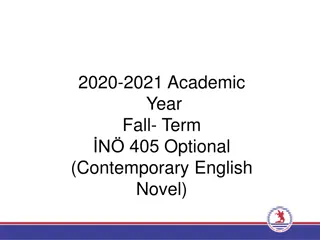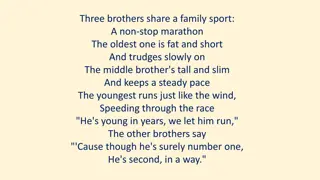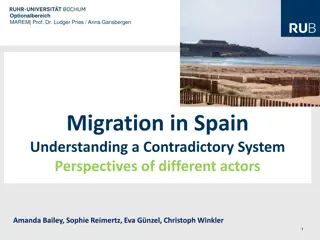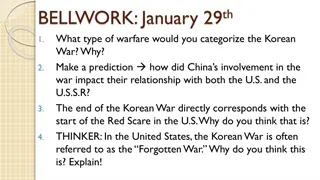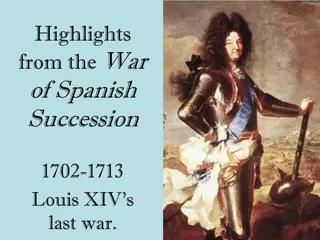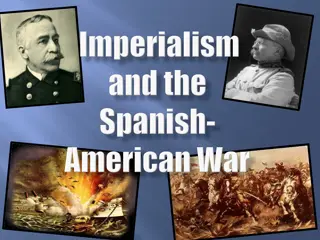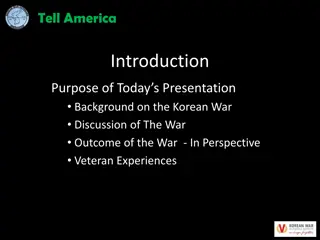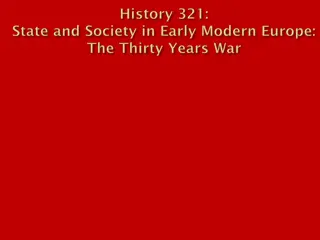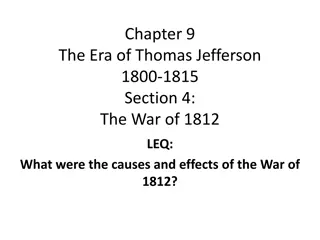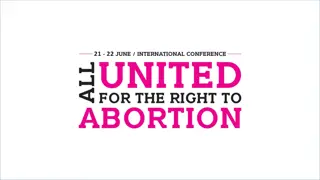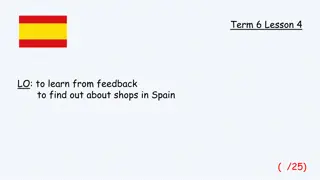The War Between England and Spain: A Historical Perspective
Elizabeth I's reign witnessed strained relations between England and Spain, leading to a conflict rooted in political, religious, and territorial disputes. The Netherlands emerged as a focal point of contention, with both nations vying for control amidst internal rebellions and external pressures. Elizabeth's cautious maneuvering and Spain's aggressive strategies set the stage for a prolonged conflict that shaped the historical landscape of Europe. The war's impact transcended borders and encompassed diverse theaters of engagement, highlighting the complexities of power dynamics and alliances during this turbulent period.
Uploaded on Oct 06, 2024 | 2 Views
Download Presentation

Please find below an Image/Link to download the presentation.
The content on the website is provided AS IS for your information and personal use only. It may not be sold, licensed, or shared on other websites without obtaining consent from the author.If you encounter any issues during the download, it is possible that the publisher has removed the file from their server.
You are allowed to download the files provided on this website for personal or commercial use, subject to the condition that they are used lawfully. All files are the property of their respective owners.
The content on the website is provided AS IS for your information and personal use only. It may not be sold, licensed, or shared on other websites without obtaining consent from the author.
E N D
Presentation Transcript
The story so far When Elizabeth came to the throne, England was a close ally of Spain. Despite their religious differences, initially Philip wanted to remain Elizabeth s ally.
However Relations with Spain deteriorated for a number of reasons: Mary, Queen of Scots Elizabeth s excommunication The Netherlands
Why does Spain care about the Netherlands? Traditionally Habsburg lands Nobles in the Netherlands had been used to some independence. Netherlands was home to a growing number of Calvinists Dutch rebels were challenging Spanish rule 1567: Duke of Alba sent to crush the rebellion.
Why does Elizabeth care about the Netherlands?
1567-84 Some of Elizabeth s councillors (e.g. Leicester and Walsingham) urge Elizabeth to take military action against Spain Elizabeth is cautious. Her privateers harass Spanish ships and allows Dutch rebels to stay in English ports. Spain is increasingly aggressive and the Spanish ambassador is implicated in the Ridolfi and Throckmorton plots
The War with Spain 1584 Treaty of Joinville: Spain and French Catholics sign a treaty. Elizabeth appears surrounded! 1585 Elizabeth signs the Treaty of Nonsuch with the Dutch Rebels Elizabeth sends 7000 troops to the Netherlands under Leicester
God blew and they were scattered So what, now So what, now what? what?
The continuing war with Spain War continues England is never invaded (although Spain try) The war is still going on when Elizabeth dies So where does the war take place?
Where were the main areas of war? Netherlands At sea/in Spanish ports In the New World France
The Netherlands 1589: Willoughby scores a victory over Spanish army in the Netherlands 1590s: English force of 8000 men help rebel leader Maurice of Nassau score victories over Spanish in Netherlands In 1594 Dutch rebels secure the Northern part of the Netherlands and it becomes independent from Spanish control
At sea/in Spanish ports 1596: Burning of Cadiz Essex wants to keep a permanent base there but is overruled The English fail to destroy the rest of the fleet in Lisbon October 1596: Philip sends another Armada to England, but it fails because of the weather 1597: Essex and Raleigh attempt to attack the Spanish fleet in Northern Spain. Indecisiveness, disagreements and bad weather mean they are unsuccessful. 1597: Philip tries to send an Armada for the third time. He fails.
Whats France got to do with it? France was in a state of chaos Divided between Catholics, Protestants and various factions In 1584 Spain had signed the Treaty of Joinville with Catholic League (Guise family). See Red part of map However, there were a significant number of Protestants (Huguenots)
1589: Henry III is murdered Henry IV comes to the throne. He is a Protestant. This leads to civil war
Henry IV asks Elizabeth for help against the Catholic League 1589 Elizabeth sends Henry IV a loan of 20,000 and 4000 men under Willoughby 1590: Duke of Parma invades France from the Spanish Netherlands 1592: Elizabeth sends a English force to Normandy under Essex (who achieves nothing). 1593: Henri IV declares himself a Catholic in order to end the war
How successful was foreign policy 1585- 1603? War with Spain Evidence of Success Evidence of Failure Overall Judgement /10 Netherlands At Sea/New World France Overall
How successful was foreign policy 1585-1603? Overall Judgement /10 War with Spain Evidence of Success Evidence of Failure Willoughby a better commander than Leicester. Victories in the aftermath of the Armada. English forces help Maurice of Nassau in early 1590s. . By 1594 Northern N lands is independent and Protestant, partly as a result of help from English. Leicester s expedition a disaster. Led to resentment from Dutch and no great benefit militarily. Stanley and Yorke s desertions boosted Parma. Netherlands Expedition to Portugal 1589 is a distraction. Led by privateers rather than the Crown meant Eliz had to spend less money. Many made a profit. Eliz made 80,000 after seizure of Madre de Dios. Distracted the Spanish ships and cost them money. Seizure of Cadiz in 1596 was humiliating for Philip and this stopped merchant ships from West Indies landing. Led to bankruptcy for Philip. Not all privateers made a profit. Historians argue that they angered the Spanish without making significant gains. At Sea/New World 1596 expedition to Cadiz failed to capitalise on gains. No attempt to destroy Spanish fleet at Lisbon or hold Cadiz. Leaders disunited and many were mainly interested in profit. MacCaffery A muddle of contradictory purposes . Lack of strategy. 1597 after failure to destroy fleet in Ferrol ships go to Azores for plunder. Support for Henri makes an ally of him. Some successes (e.g. John Norris fortress of Cozon). Distracts Spain from Netherlands. Henri has to convert to Catholicism. Costs Elizabeth a lot of money (and more than she wants to pay) France Overall
